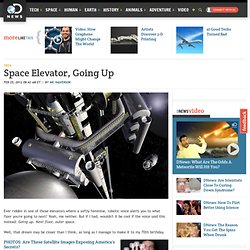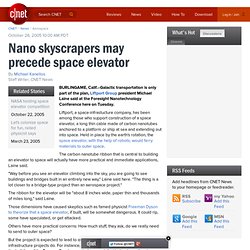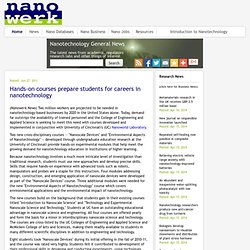

CCT Space Elevator Blog - #CCT506 Take a look at our space elevator project... Obayashi Global. Space Elevator, Going Up. Ever ridden in one of those elevators where a softly feminine, robotic voice alerts you to what floor you're going to next?

Yeah, me neither. But if I had, wouldn't it be cool if the voice said this instead: Going up. Next floor, outer space. Well, that dream may be closer than I think, as long as I manage to make it to my 70th birthday. PHOTOS: Are These Satellite Images Exposing America's Secrets? According to The Daily Yomiuri, Tokyo construction company, Obayashi Corporation, hopes to erect a space elevator by 2050. How is this possible? At the end of a 59,652-mile-long, carbon-nanotube cable, there would be a counterweight floating in space and anchoring the assembly connected to the ground terminal. Interested in beaming yourself up? Obayashi is keeping mum about the estimated cost of the project, but once it's off the ground, the company hopes to shuttle 30 passengers at a time along the cable, potentially with magnetic linear motors.
BLOG: Space Bacteria Boost Cell Power via Gizmag. Nano skyscrapers may precede space elevator. BURLINGAME, Calif.

--Galactic transportation is only part of the plan, Liftport Group president Michael Laine said at the Foresight Nanotechnology Conference here on Tuesday. Hands-on courses prepare students for careers in nanotechnology. While these applications are evolving, there are already some 800 commercial products using nanomaterials.

To name just a few: nanoparticles added to polymer composites provide durability and resiliency in baseball bats, tennis rackets, and motorcycle helmets; nanotechnology used in batteries makes them less flammable, more efficient and lighter; and many new televisions and laptop computer displays use organic light-emitting diodes (OLED) with nanostructured polymer films. According a study** by National Center for Manufacturing Sciences (NCMS) sponsored by the National Science Foundation (NSF): "Nanotechnology is no longer a technology in waiting - a great breadth and diversity of nanotechnology products and application markets are being pursued with the potential for disruptive economic, social, environmental and military advantage.
"
A space elevator may change how we explore our solar system. In the times of rockets, the best way to explore our solar system was by making orbital refueling stations.

In this way rockets would only need enough fuel to get to orbit, then they would be refueled or even added onto for the journey to the destination (let’s say Mars for example). In this video, the space elevator is a part of the system that helps us explore our solar system. I’ve been keeping my hopes unbroken. Space exploration is all around me, it is my remedy. As we explore outer space we have encountered many strange things, that will no doubt allow us to learn more about our planet, and ourselves Here are a few things that will be of concern for space travelers and those who want to settle on other planets. 1) Ever wondered how and why plants have evolved to make use of radiation to power their growth and life: 2) Well apparently planets without a magnetic field–or only a small magnetic field–are bombarded by radiation that will be a risk to settlers: Space elevator - physical principles. Ranko Artuković, Zadar, Croatia Patent No. 02-1712-29122000 HAA Click here for Croatian version of this document Be serious and don't be surprised at the following question: Ý Have you ever seen the rope hanging from the space?

Or, better to say the rope which end disappears in the azure of the sky? However, believe me, I'll exactly prove in this article: the rope that hangs from the sky is absolutely possible and that without any conjuring tricks. How To Build A Space Elevator And Become An Interplanetary Civilization. To help humanity explore the universe and spread to the stars, we first need to escape the gravity well of planet Earth.

The only way to do that right now is to ride a rocket – which takes an enormous amount of energy and money, especially if you want to send anything bigger than a mobile phone into orbit. Rockets are useless for the kind of offworld commuter solution we’ll need if we’re going to become an interplanetary civilization – let alone an interstellar one. That’s why an international team of scientists and investors are working on building a space elevator. Using very little energy, these 100,000km-high elevators could carry travelers out of the gravity well and up to a spaceship dock. If you want a glimpse of tomorrow’s morning commute, you need to know about the space elevator. Top image by Michael Evans. Audacious & Outrageous: Space Elevators.
Inspired partly by science fiction, NASA scientists are seriously considering space elevators as a mass-transit system for the next century.

Listen to this story (requires RealPlayer) Sept. 7, 2000 -- "Yes, ladies and gentlemen, welcome aboard NASA's Millennium-Two Space Elevator. Your first stop will be the Lunar-level platform before we continue on to the New Frontier Space Colony development. The entire ride will take about 5 hours, so sit back and enjoy the trip.
As we rise, be sure to watch outside the window as the curvature of the Earth becomes visible and the sky changes from deep blue to black, truly one of the most breathtaking views you will ever see! " Does this sound like the Sci-Fi Channel or a chapter out of Arthur C. Above: Artist Pat Rawling's concept of a space elevator viewed from the geostationary transfer station looking down along the length of the elevator toward Earth. "This is no longer science fiction," said Smitherman. Smitherman's paper credits Arthur C. More. The Space Elevator Reference. 2011 Space Elevator Conference.